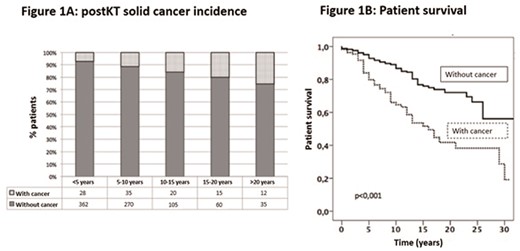-
PDF
- Split View
-
Views
-
Cite
Cite
Anna Buxeda, Dolores Redondo, María José Pérez, Alvaro Bartolome, Marisa Mir, Ana Pascual, Ana Sans, Marta Crespo, Julio Pascual, SP759
RISK DETERMINANTS OF SOLID ORGAN CANCER AFTER KIDNEY TRANSPLANTATION, Nephrology Dialysis Transplantation, Volume 32, Issue suppl_3, May 2017, Pages iii399–iii400, https://doi.org/10.1093/ndt/gfx157.SP759Close - Share Icon Share
INTRODUCTION AND AIMS: Cancer after kidney transplant (KT) is the only cause of death that is increasing.
METHODS: We analyzed incidence, risk factors and characteristics of postKT solid cancers at our center in 942 KT recipients (tx1979-2014), followed until April-2016. Solid organ tumors and lymphomas were analyzed, excluding skin tumors.
RESULTS: 110 patients (11,7%) developed solid organ tumors (9%) or lymphoma (2,7%). The medianpostKT time to diagnosis was 6 years (IQR 3,1-10,7), estimated incidence 18,3 cases/year, or 2121 cases/100.000 inhab/year. The estimated incidence in general population in our community is 520/100.000 inhab/year: 4,1 times lower than in KT population. Solid organs affected were: lung(30%), bladder(11%), prostate(11%) and native kidney(7%).The prevalence of cancer in patients followed for a very long period is extremely high (25% of patients who reach 20 years after KT).Patients who developed cancer had received more thymoglobulineas induction therapy (31% vs 18%, p=0.002) and cyclosporine (47.3 vs 32.5%, p=0,003). In multivariate analysis, adjusted cancer risk factors: thymoglobuline induction [OR 1.752, 1.073-2.861; p=0.025] and time afterKT [OR 1.061 (1.017-1.105)/year; p=0,005]. Cancer was associated with much lower patient survival.

SP759 Figure





Comments